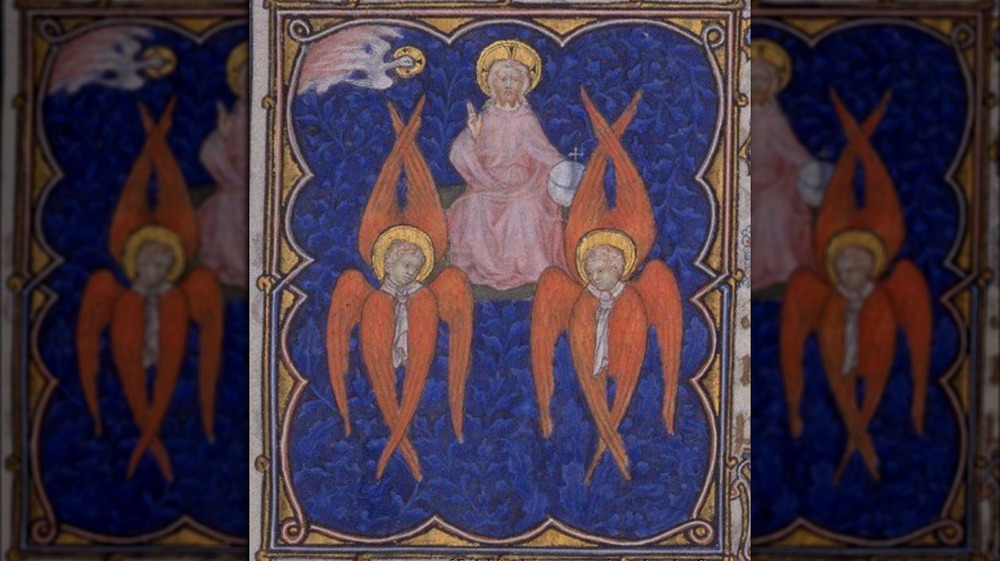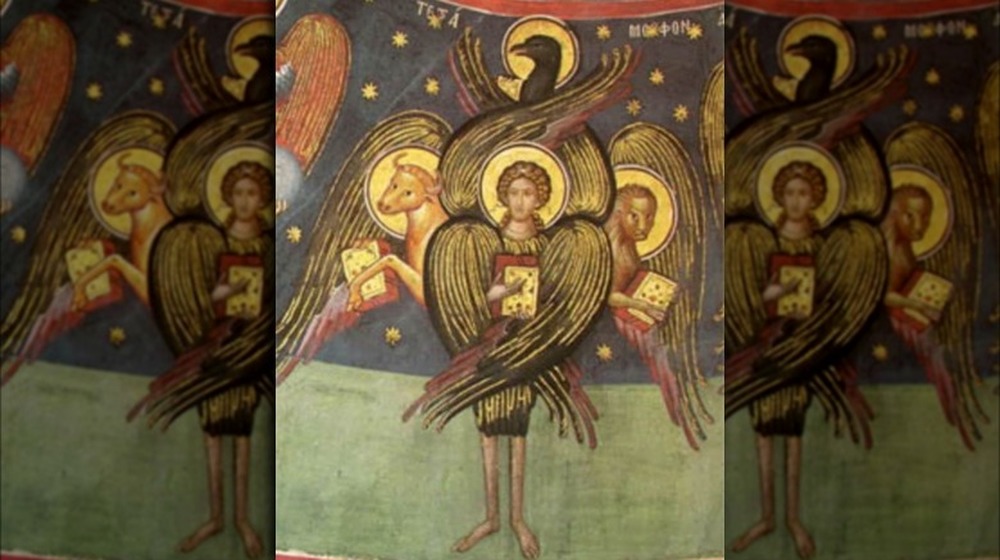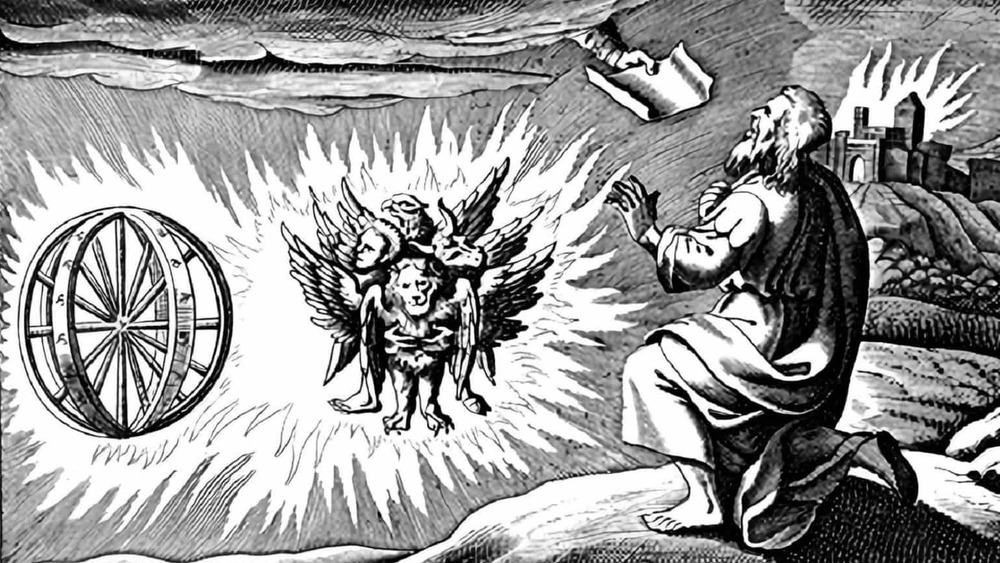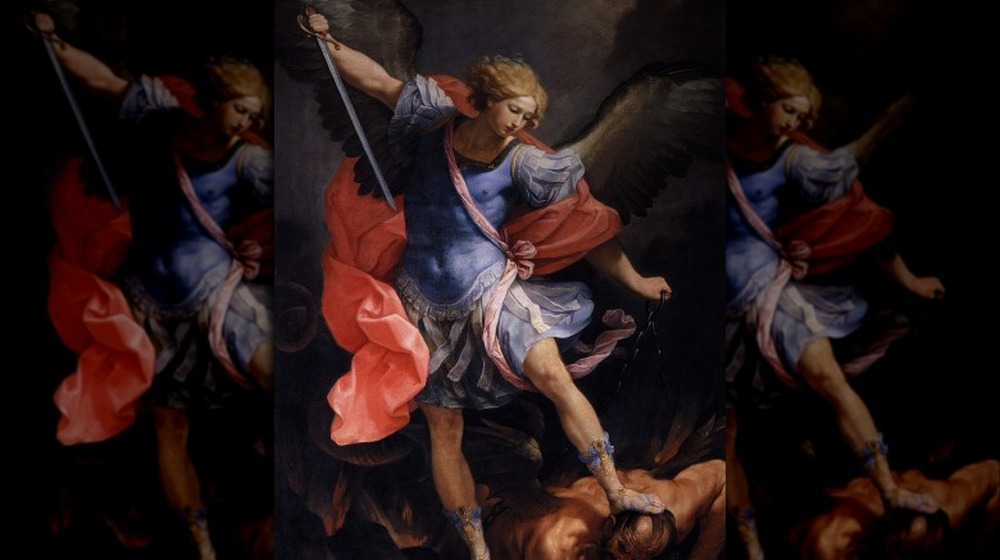This Is What Angels Really Looked Like In The Bible
If you've ever been told "You look like an angel!", you probably took that as a compliment. But a closer look at the Bible reveals that you probably should have felt insulted.
Today, there's a stereotypical look that most angels have when shown in works of art or popular culture. Generally, angels are depicted as beautiful, pale-skinned humans with wings, wearing white robes, carrying a harp, and sporting a halo. But this look is far from the actual version of angels described in the Bible. Biblical angels were generally strange, frightening creatures, ranging from human-lion-ox-eagle hybrids to floating wheels with eyes. Biblical angels struck fear into the hearts of anyone who witnessed them.
This discrepancy between Biblical angels and their pop-culture depictions has been pointed out by many internet users; it's even been the subject of a running meme throughout 2020. So, we're here to explain what Biblical angels actually looked like. Prepare for it to get weird, though as angels themselves would reassure us, "Be not afraid."
Cherubs aren't cute little babies - they're terrifying human-animal hybrids
One of the most vivid descriptions of angels in the Bible comes from the prophet Ezekiel's inaugural vision, found in Ezekiel 1. It describes two main types of angels. The first are the cherubim (which is plural; singular is cherub). Per Medium, cherubs have been assigned a variety of tasks by God, one of the most important of which is to guard the Garden of Eden.
Now, if you've heard of cherubim before, you probably don't think of them as the scary guard type; today, cherubs are typically depicted as chubby little babies. But the Bible disagrees. According to Ezekiel's vision, every cherub "had the face of a human being, and on the right side each had the face of a lion, and on the left the face of an ox; each also had the face of an eagle." If the combined faces of four different species aren't frightening enough, cherubs also have two sets of wings; one for flight, and the other to conceal their bodies. Additionally, per Medium, cherubs have straight legs and shiny bull hooves.
The Bible's frightening depiction of cherubs is a far stretch from how they're traditionally shown today. But the second type of angel described in Ezekiel 1 is even more bizarre. Meet the ophanim (singular: ophan).
Other Old Testament angels are described as interlocking wheels and covered in eyes
According to Medium, ophanim comes from the Hebrew word for "wheels." It's a fitting name, because Ezekiel's vision suggests that some of God's angels are actually floating, eye-covered wheels. Per Ezekiel 1, "Each appeared to be made like a wheel intersecting a wheel... Their rims were high and awesome, and all four rims were full of eyes all around." Further, the ophanim are said to "sparkle like topaz," and to hover in the air as they mimic the motion of the cherubim. Per Ezekiel, both the cherubim and ophanim help to guard the throne of God himself. (Given their frightening description, they're certainly good picks for the job.)
A different type of angel, seraphim (singular: seraph), is described in the Book of Isaiah. Per Isaiah's vision in Isaiah 6, "I saw the Lord, high and exalted, seated on a throne... Above him were seraphim, each with six wings: With two wings they covered their faces, with two they covered their feet, and with two they were flying." If you're keeping count, that means that the seraphim have one more set of wings than the cherubim, but lack the extra faces. Also, the seraphim aren't guards like the cherubim and ophanim, but rather serve to sing God's praises. Per Isaiah, as they hover around God's throne, the seraphim can be heard singing, "Holy, holy, holy is the Lord Almighty; the whole earth is full of his glory."
Messenger angels looked more like humans
Another prominent class of angels are the messengers of God. Per Blue Letter Bible, the angels that God chose to deliver his messages could take a variety of corporeal forms. Most commonly, they would appear nearly identical to a human male. This is true for the warrior archangel Michael, who first appears in the Book of Daniel. It likewise applies to the archangel Gabriel, who informed Mary that she would give birth to Jesus. In fact, most of the angels referenced in the New Testament appear to be more humanlike and tame than their frightening Old Testament counterparts. For example, Luke describes the angels at Jesus' tomb as "two men in shining garments."
This might give you the impression that the angels you see in popular culture are accurate depictions of angels as they're described in the New Testament. That's wrong. As Blue Letter Bible points out, cherubim and seraphim are the only types of angels described as having wings; messenger angels like Gabriel have none. Cracked suggests that this common misconception may have emerged from medieval artists, who used wings as a means to differentiate angels from other human characters in their art.
Similarly, Cracked explains that cherubims' depiction as flying babies was adopted from the ancient Italian art of putti, a practice by which winged babies were carved into child sarcophagi. More modern still is the idea of angels playing the harp, which was first contrived by John Milton in his 1667 epic Paradise Lost.



